Unit 6 Language

Photo by Olya Kobruseva from Pexels
Overview
If there were one area that is a mirror of, or mirror to culture, it is language. Both reflect the other and have implications for revealing something about the other. In Unit 6, you will not study language, but rather, you will study linguistics. Descriptive linguistics looks at the structure of language, sociolinguistics looks at the relationship between language and society, and historical linguistics looks at how language changes over time. Some are added (though that is very rare), and many die. Much effort has been put into preserving languages, because in doing so, you preserve both a way of life and a way of thinking about life and the world.
Topics
This unit is divided into the following topics:
- Fundamentals of Language
- Descriptive Linguistics
- Sociolinguistics
- Language Diversity, Learning, Change, and Preservation
Learning Outcomes
When you have completed this unit, you should be able to
- Explain the relationship between language and culture.
- Identify the universal features of languages and the design features that make them unique.
- Describe the structures of language: phonemes, morphemes, syntax, semantics, and pragmatics.
- Assess the relationship between language variations and ethnic or cultural identity.
- Explain how language is affected by social class, ethnicity, gender and other aspects of identity.
- Evaluate the reasons why languages change and efforts that can be made to preserve endangered languages.
Activity Checklist
Here is a checklist of learning activities you will benefit from in completing this unit. You may find it useful for planning your work.
Resources
- In this section we will look at language and examine some interesting examples involving colours. Carefully read through these resources and be prepared to share your thoughts during the Learning Lab.
- At the bottom of the page in Topic 2, students will find some important resources. There are a number of readings and slides for you to review. Additionally, take a few moments to watch through the video.
- At the bottom of the page in Topic 3, students will find some important resources. There are a number of readings and slides for you to review.
- In this section of Topic 4, students will be viewing some videos. These videos are intended to challenge your thinking about language. These resources will help you prepare for the discussion that will be taking place in the “Learning Lab” and the “Assessment” sections for Unit 6.
During this Learning Lab, your Facilitator will introduce you to the final project in the course: the Culture Trait Presentation. While this assignment is not due until the end of Unit 10, students will need to identify a topic for their research. More information about this assignment can be found by clicking on the “Unit 10” tab at the top of the page.
In addition, students will also be participating in a graded discussion during this Learning Lab. Information about this discussion can be found on the “Assessment” tab in Unit 6. Carefully review this assignment and prepare your thoughts before arriving to the Learning Lab.
As mentioned above, students will be participating in a graded discussion that focuses on Language - this graded discussion will take place during the Learning Lab for Unit 6.
To help prepare for this discussion, review the questions found on the “Assessment” tab for this unit. Additionally, the videos you viewed in Topic 4 will also help prepare you for this discussion.
Resources
Here are the resources you will need to complete this unit:
- Brown, N., de González, L. T., McIlwraith, T. F., & American Anthropological Association. (2018). Perspectives: An Open Invitation to Cultural Anthropology.
- Dastrup, R. A. (2019). Introduction to Human Geography.
- Wesch, M. (2018). The Art of Being Human: A Textbook for Cultural Anthropology. New Prairie Press.
- The Power of Language
- Other online resources will be provided in the unit.
6.1 The Fundamentals of Language
The subject of language is one of the most challenging elements of Anthropology to understand. For something that is such a focus of day-to-day life, the impact of language is something that cannot be understated.
Learning a new language is incredibly challenging for many reasons. One of the biggest challenges of learning a language is that people do not necessarily write like they talk - learning how to write a new language can be entirely different from learning how to speak a new language.
Another challenging situation is learning a language among people who do not read and write. As a result, they may conceptualize language in a completely different way - for example, they may not view language as a collection of words.
Both of these scenarios highlight how complex communication can be among humans. Non-verbal cues, symbolism, metaphors, and cultural nuances are important elements that demand awareness and appreciation.
6.2 Descriptive Linguistics
Descriptive linguistics involves analyzing and describing how language is used by a community or culture. As we saw in the previous section, much of how humans communicate involves no words at all. This allows for many different interpretations depending on how your cultural background has shaped your views.
The reality is that there are many universal features of human language, but there are (arguably) just as many culturally unique features to human language. Each person’s social identity will shape their understanding of language and how they use language. This needs to be an important focus of awareness in order to appreciate these intricacies.
Resources
The resources below will help you better understand the content explored in this unit. Take some time to explore this material - it will be discussed during the Learning Lab and will play an important role in course assessments.
Activity
Activity Reading #1
Take some time to read through the slides below. Follow along with them as you read through the activities below:
Click to Open
Learning Objectives
- Human language and culture
- People communicate without words
- Universal features of human language
- Unique features of human languages
- The structures of language
- Social identity shapes language and is shaped by it
- Language change (historical linguistics) and preservation
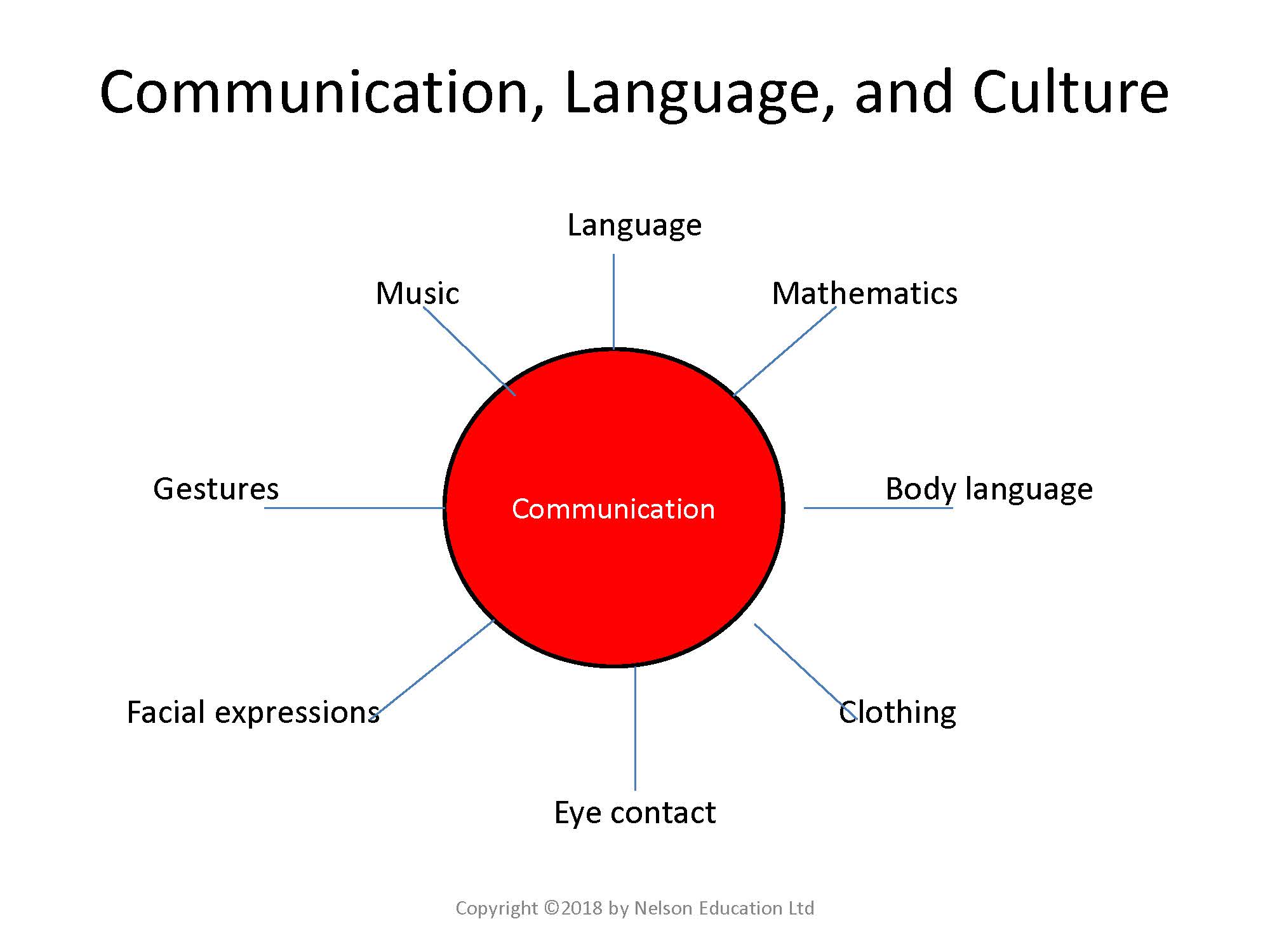
image of diagram showing various aspects of Communication
Language and Meaning
- Aoccdrnig to a rscheearch at an Elingsh uinervtisy, it deosn’t mttaer in waht oredr the Itteers in a wrod are, the olny iprmoetnt ting is taht the frist and Isat Itteers are at the rghit pclae. The rset can be a toatl mses and vou can sitll raed it wouthit porbelm. Tihs is buseae we do not raed ervey Iteter by it slef but the wrod as a wlohe.
The Importance of Human Language to Human Culture
- Language can be considered …
- Language and … are …
- Relies on …
- Arbitrariness
- Arbitrariness
- In learning another language, …
Communication Systems
- Non-verbal communication includes
- … (body language)
- … (use of space)
- Paralanguage (…)
- … (body language)
Human Language Compared with the Communication Systems of Other Species
- Hockett’s Design Features - …
- … shares all characteristics and includes these features:
- …
- … of patterning
- …
- Productivity/…
- …
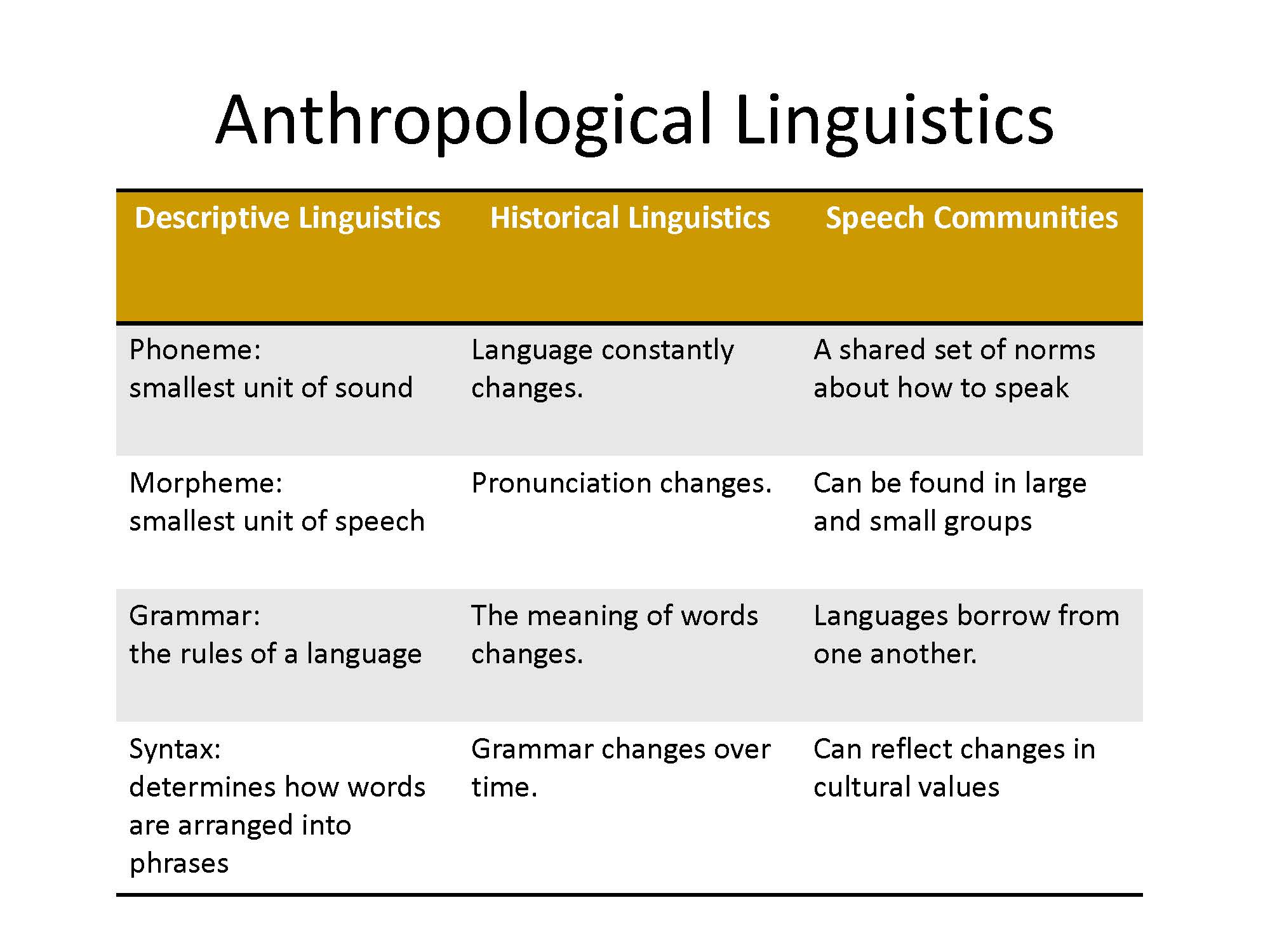
image of chart showing various aspects of Anthropological Linguistics
Descriptive Linguistics: Structures of Language
- Phoneme - …
- Morpheme - …
- Syntax - …
- Semantics - meanings of words
- Pragmatics - …
PHONOLOGY
- Humans can make about … different sounds. About… of these are used …, with most languages using about … different sounds. (Wesch, 2018, p.108)
- Phonology/Phonetics: …
- Includes accent - …, …, stress, and …
- Sounds excluded from vour own … are difficult to imitate.
- Questions:
- How many phonemes does English have?
- How many phonemes does English have?
- How many sounds are there in the world?
- How many sounds are there in the world?
- What are some commonly difficult sounds for learners of English as a second language?
- Includes accent - …, …, stress, and …
MORPHOLOGY
- Morphology: …
- Morpheme = ….
- prefix + … + suffix
- prefix + … + suffix
- Morpheme = ….
- Word = a …
- Examples: s-u-n
- phil - anthrop - ist
- non -trans -fer - able
- phil - anthrop - ist
Why the words for “Mom” and “Dad” are so similar across languages
- Have you ever thought about the origins of the words for “mother” and “father”? Isn’t it striking that they are so similar across languages? Using recent material, Prof. Handke provides several arguments why this is so and why these similarities are not at all surprising.
 image of a diagram showing Morphemes Make Words
image of a diagram showing Morphemes Make Words
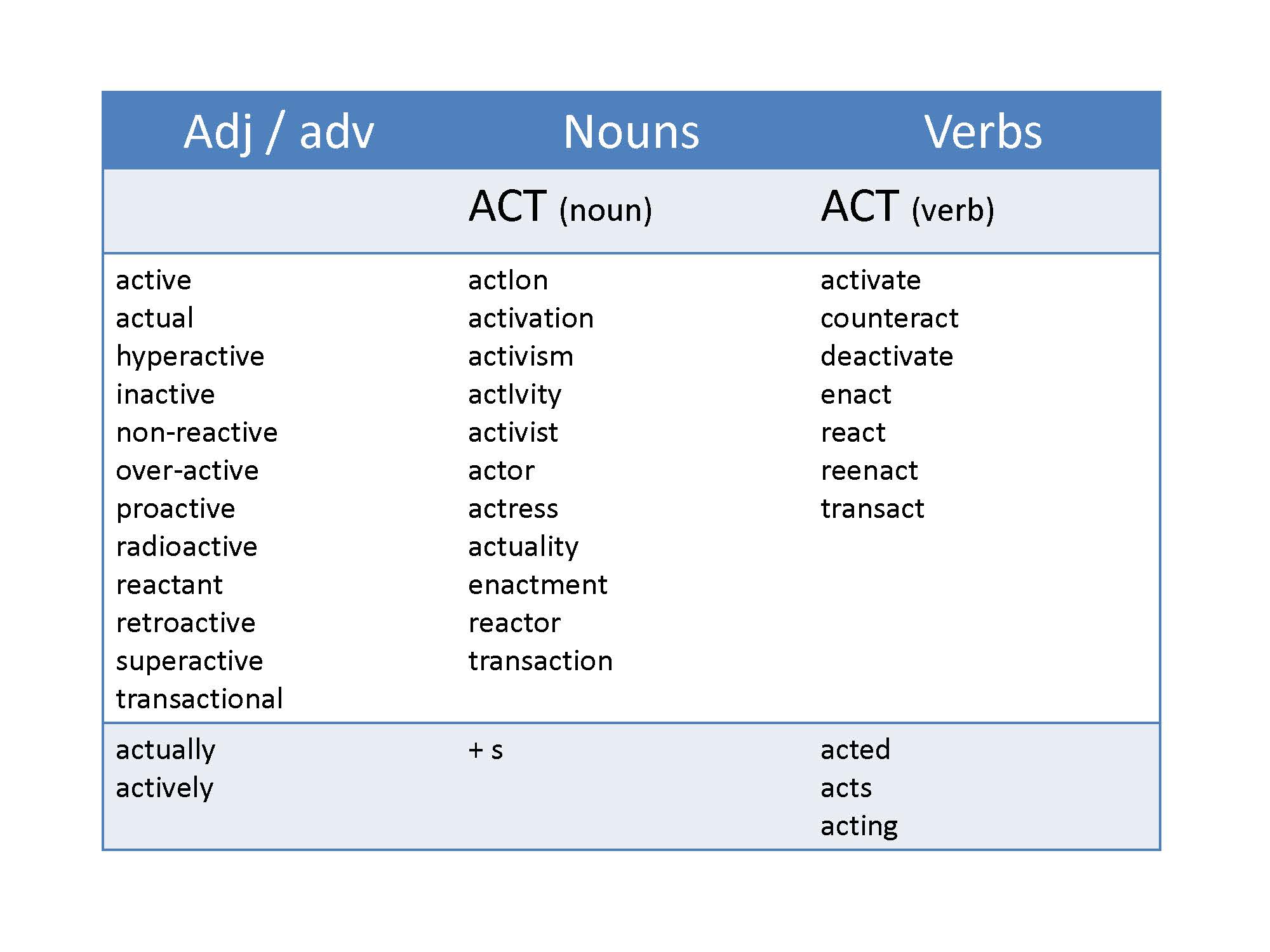 image of a diagram showing Adj/adv, Nouns and Verbs
image of a diagram showing Adj/adv, Nouns and Verbs
SYNTAX
- Syntactics - …
- … to meaning.
- Example:- The dog bit the man OR The man bit the dog.
SEMANTICS
- Def: …
- Denotation - …
- Connotation - …
- Idioms: …, therefore focus on …
Sociolinguistics
- What we say and how we say it is … influenced
- Language - …
- Dialect - often used for … (result of colonization)
- Many reasons for … …
- Registers - …
- … - use of several varieties of language in a particular interaction
Dialects and Accents
- How are you today?
- How va doin’?
- Me mudder and me fadder
- Don’t nobody go nowhere.
- Dialect …
- Standard language …; is the most prestigious. In Britain, it is sometimes called “…”
- Accent … It can characterize …, regions, …, …, …, or other …
Diglossia and Code Switching
- Diglossia : …
- Context determines which … is used (e.g., one form is for the business community; another form for conversations between friends). E.g. … vs … forms
- …: when speakers of two or more languages or varieties of one language switch between the two, depending on the social context
- Found in …, each with its own …
Language Variation
- Linguistic Relativity (the Whorf Hypothesis)
- … found no present, past, future tense in the …
- Language shapes the …
- How we see our world, influences …
- … our choice of words and our …
- The words we use to … is a clue to …
Where the Sky is Not Blue
- Recall this section of Wesch’s chapter (p. 116) which discusses how we see our world, and how we choose our words. If there is no word for blue in a language, does that mean that society does not see the color blue?
- Read It’s not easy seeing green
- What do you see? Do you detect which one is different?
- httos://languagelog.Idc.upenn.edu/nll/?o=17970
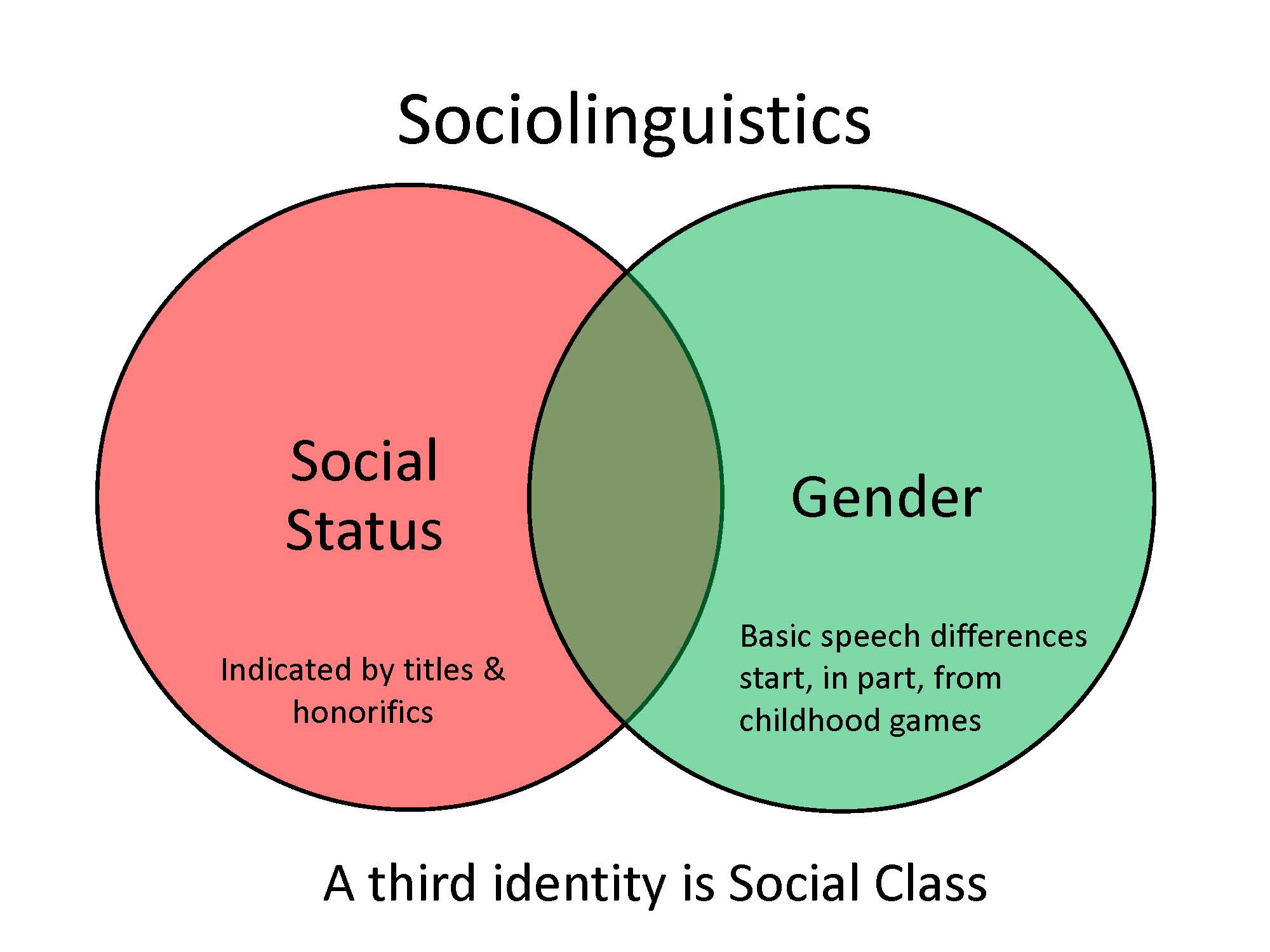 image of a diagram showing Sociolinguistics elements
image of a diagram showing Sociolinguistics elements
Historical Linguistics & Language Change
- Language taxonomies - …, create a …
- Globalization, …, and urbanization often leads to …
- … extinction/language …
- Language shift
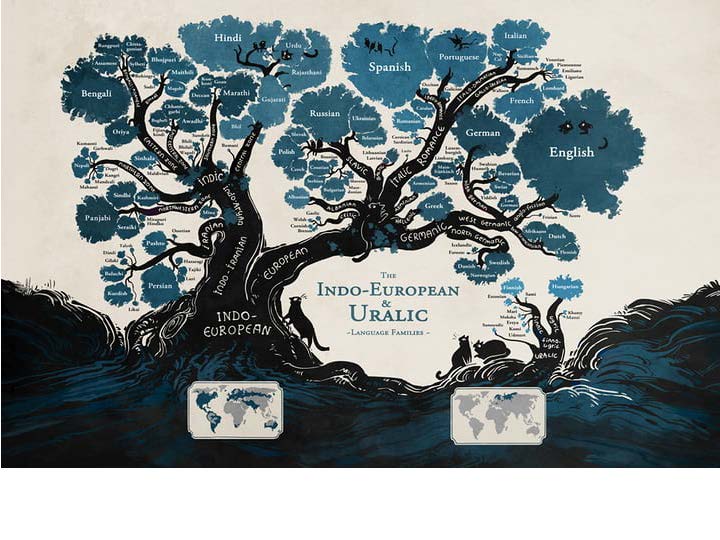 image of the Indo-European and Uralic language family tree
image of the Indo-European and Uralic language family tree
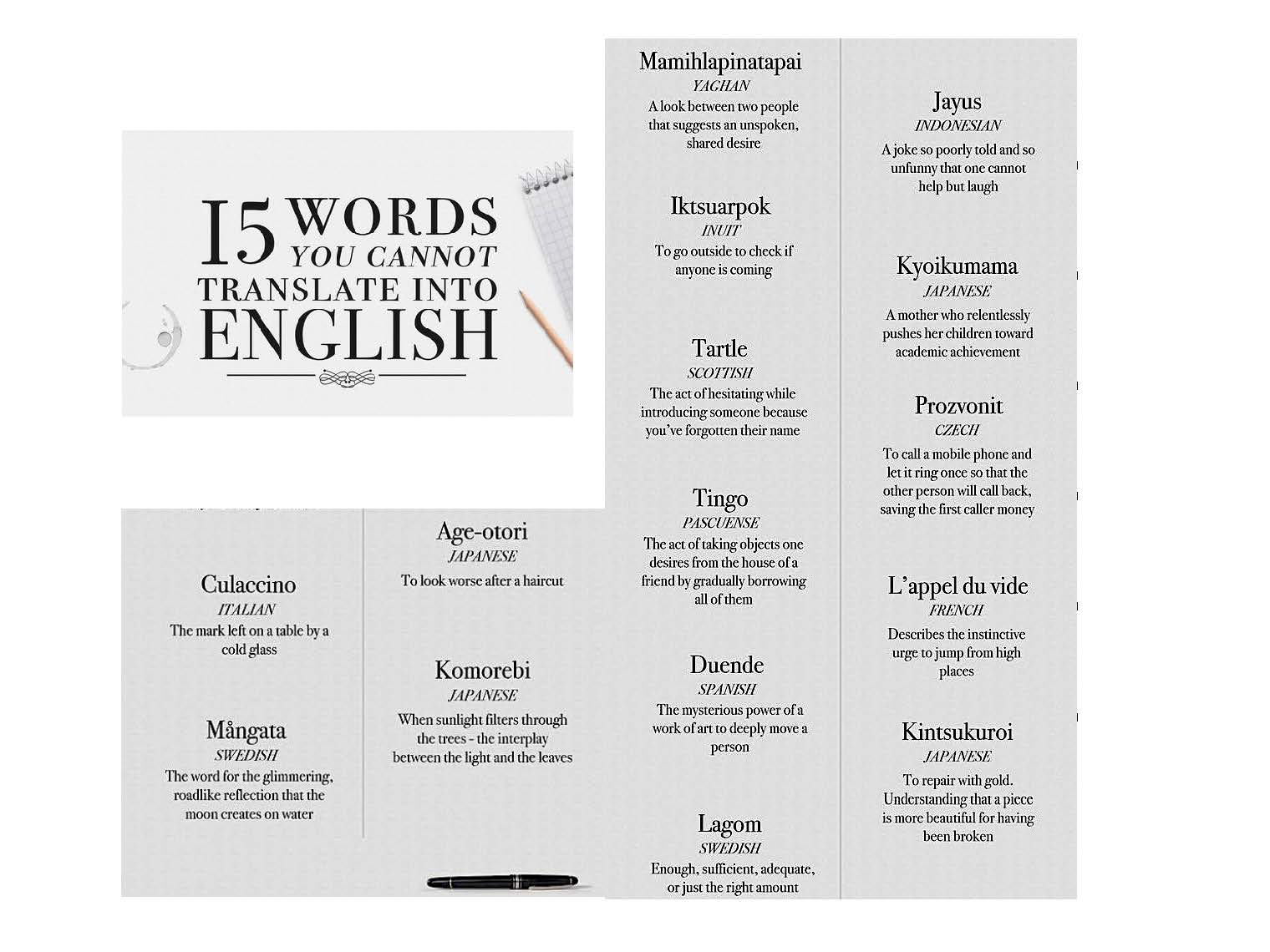 image of 15 words that cannot be translated into English
image of 15 words that cannot be translated into English
The Future of English
- Number of speakers of English as a …
- US: nearly …% of Americans speak a … at home
- Multi-lingualism is …
- Globally, the number of … is expected to drop from the current …% to …% by …
The Future of Other Languages
- Chinese is …
- Hindi-Urdu and …
- Spanish nearly …
- French is the …
- English? To remain …
- What is the best language to learn, as a ‘second language’?
 image of hardest languages to learn
image of hardest languages to learn
Endangered Languages
- In … there were … living languages
- Language diversity is …
- Endangered language: a language at …
- Some cultures are trying to …
- One language goes extinct every … or … days, with no …
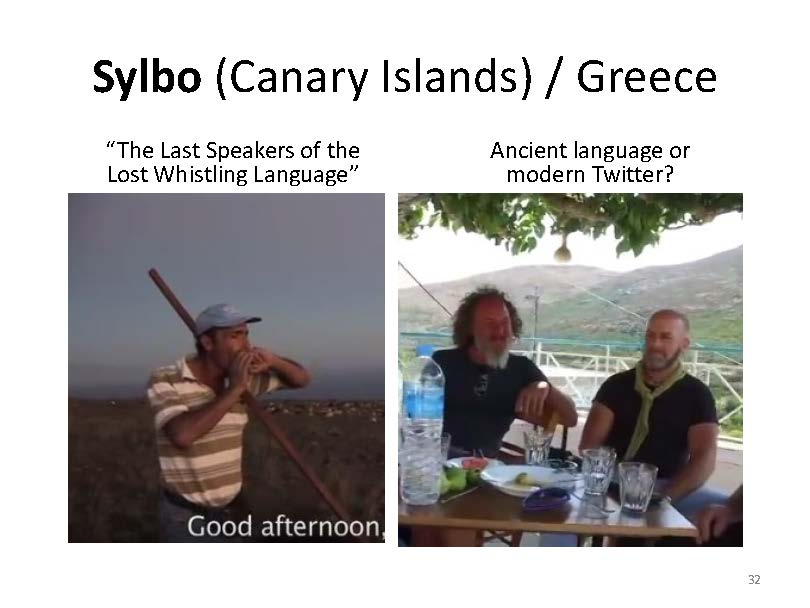 image of two pictures with men from Sylbo (Canary Islands)and Greece
image of two pictures with men from Sylbo (Canary Islands)and Greece
6.3 Sociolinguistics
In addition to everything we studied in the previous section, it is important that we consider language in relation to social factors. As you might have guessed, what people say and how they say it is largely influenced by culture.
Sociolinguistics helps to provide insight as to how and why people from a similar place can use different expressions or accents, for example, when discussing similar things. For example, the way individuals speak on the Westcoast of Canada can be very different then the way people speak on the East-Coast of Canada in both sound and variation in language choice. Despite being from the same country, cultural anthropologists are interested in better understanding why these varieties exist and how they happened.
6.3.1 Resources
The resources below will help you better understand the content explored in this unit. Take some time to explore this material - it will be discussed during the Learning Lab and will play an important role in course assessments.
Activity: Reading
- In the slides below, you will find some valuable information that can help you develop a better sense of sociolinguistics. This presentation will also help provide some context and understanding for the next resource below. presentation=“anth101/presentations/u11”
- This article uses a tree as a metaphor to illustrate the evolution of language. Spend some time looking at the origins of each of the languages that form the tree. See if you can find your own primary language (or look at the evolution of any other language you may speak).
6.4 Language Diversity, Learning, Change, and Preservation
As we have seen, throughout this Unit, language is not only complex and diverse, but it is also constantly evolving. Not only are cultural anthropologists interested in this evolution, but they are also interested in preserving the past.
In this final section of Unit 6, we learn about an endangered whistling language found on two island - one in the Mediterranean Sea, and the other off the coast of West Africa. As you watch, consider what role an Anthropologist might play in understanding the reasons for change, and also the reasons for preserving these unique languages.
6.5 Topic 4 Resources
The resources below will help you better understand the content explored in this unit. Take some time to explore this material - it will be discussed during the Learning Lab and will play an important role in course assessments.
6.5.1 Activity: Watch and Reflect
- CASE STUDY from one of the Spanish Canary Islands & Discussion
This first video presents an interesting example of a language on the cusp of extinction on the Canary Islands. In the age of mobile phones, the remaining “speakers” of a dying whistling language try to preserve a vital means of communication over vast distances.
Take a look:
- CASE STUDY from Greek Island & Discussion
In the Greek island village of Antio, home to the world’s most endangered language, aging residents communicate across hillsides through whistles, a specific system of communication believed to date back to Ancient Greece. Special correspondent Malcolm Brabant reports on how they hope to save their language from extinction and what it has in common with Twitter.
Learning Lab
Culture Trait Presentation
In this section, students are introduced to their final assignment for the course: The Culture Trait Presentation. While this assignment is not due until Unit 10, students will need to identify a topic and begin their research now.
To learn more about this assignment, click on the Assignment - Culture Trait tab found in Unit 10.
After reading through the guidelines for the assignment, focus on identifying a topic - your topic needs to be communicated to the Facilitator. Once your topic has been approved, it is strongly recommended that you begin your research so you can develop your presentation.
6.6 Assessment
In this Unit, we studied the nuances and complexities of language. The assessment, for Unit 6, will focus on a discussion that requires you to draw upon your understanding of our studies.
As noted in the previous section, this assessment will occur during this unit’s Learning Lab.6.6.0.1 Group Discussion: Language
Take some time to reflect on the content of this unit. During the time allocated to a Learning Lab for this unit, you will be asked to share your thoughts on the following:
- Can whistling be regarded as a language? (Be sure to provide reasons to support your position)
- Can you use the same rationale for arguing that sign language is (or is not) a language?
Be sure to include ideas and concepts from throughout the Unit to support your position(s).
The following criteria will be used to grade your contribution to this discussion:
: | :– | :- |
A | 4 | Outstanding contribution and follow-up comments that inspire a rich and fruitful discussion. Demonstrates understanding of material as well as an ability to tie the material to larger ideas, making rich connections and evoking deep and interesting questions. Thus, evidence of thorough preparation, i.e. reading or viewing the required material. |
B | 3 | Evidence of some preparation, and consequently comments lack understanding or insight. |
C | 2 | Minimal contribution. Or, not having read or viewed the required material that is the basis of the discussion topic. |
D | 0 | No contribution or a contribution that feels rushed like it was “just something that had to be done for the grade.” |
The evaluation of this will count towards the 4% awarded for participation. It will be based on the degree of creative thinking demonstrated by each student during the discussion. Students will be assessed during the discussion.
Checking Your Learning
Before you move on to the next unit, check that you are able to:
- Explain the relationship between language and culture.
- Identify the universal features of languages and the design features that make them unique
- Describe the structures of language: phonemes, morphemes, syntax, semantics, and pragmatics
- Assess the relationship between language variations and ethnic or cultural identity
- Explain how language is affected by social class, ethnicity, gender and other aspects of identity.
- Evaluate the reasons why languages change and efforts that can be made to preserve endangered languages.